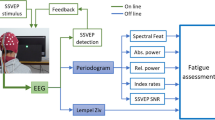Abstract
We present two techniques utilizing independent component analysis (ICA) to remove large muscle artifacts from transcranial magnetic stimulation (TMS)-evoked EEG signals. The first one is a novel semi-automatic technique, called enhanced deflation method (EDM). EDM is a modification of the deflation mode of the FastICA algorithm; with an enhanced independent component search, EDM is an effective tool for removing the large, spiky muscle artifacts. The second technique, called manual method (MaM) makes use of the symmetric mode of FastICA and the artifactual components are visually selected by the user. In order to evaluate the success of the artifact removal methods, four different quality parameters, based on curve comparison and frequency analysis, were studied. The dorsal premotor cortex (dPMC) and Broca’s area (BA) were stimulated with TMS. Both methods removed the very large muscle artifacts recorded after stimulation of these brain areas. However, EDM was more stable, less subjective, and thus also faster to use than MaM. Until now, examining lateral areas of the cortex with TMS—EEG has been restricted because of strong muscle artifacts. The methods described here can remove those muscle artifacts, allowing one to study lateral areas of the human brain, e.g., BA, with TMS—EEG.






Similar content being viewed by others
References
Brookings T, Ortigue S, Grafton S, Carlson J (2009) Using ICA and realistic BOLD models to obtain joint EEG/fMRI solutions to the problem of source localization. Neuroimage 44:411–420
Clancy EA, Morin EL, Merletti R (2002) Sampling, noise-reduction and amplitude estimation issues in surface electromyography. J Electromyogr Kinesiol 12:1–16
De Lucia M, Fritschy J, Dayan P, Holder DS (2008) A novel method for automated classification of epileptiform activity in the human electroencephalogram-based on independent component analysis. Med Biol Eng Comput 46:263–272
Delorme A, Makeig S, Sejnowski T (2001). Automatic artifact rejection for EEG data using high-order statistics and independent component analysis. In: Proceedings of the 3rd International Workshop on ICA, San Diego, pp 457–462
Fitzgerald PB, Maller JJ, Hoy K, Farzan F, Daskalakis ZJ (2009) GABA and cortical inhibition in motor and non-motor regions using combined TMS-EEG: a time analysis. Clin Neurophysiol 120:1706–1710
Greco A, Mammone N, Morabito FC, Versaci M (2005) Semi-automatic artifact rejection procedure based on kurtosis, Renyi’s entropy and independent component scalp maps. World Acad Sci Eng Technol 7:22–26
Hamidi M, Slagter HA, Tononi G, Postle BR (2010) Brain responses evoked by high-frequency repetitive transcranial magnetic stimulation: an event-related potential study. Brain Stimul 3:2–14
Hyvärinen A (1999) Fast and robust fixed-point algorithms for independent component analysis. IEEE Trans Neural Netw 10:626–634
Hyvärinen A, Oja E (1997) A fast fixed-point algorithm for independent component analysis. Neural Comput 9:1483–1492
Hyvärinen A, Oja E (2000) Independent component analysis: algorithms and applications. Neuronal Netw 13:411–430
Ilmoniemi RJ, Virtanen J, Ruohonen J, Karhu J, Aronen HJ, Näätänen R, Katila T (1997) Neuronal responses to magnetic stimulation reveal cortical reactivity and connectivity. Neuroreport 8:3537–3540
Ives JR, Rotenberg A, Poma R, Thut G, Pascual-Leone A (2006) Electroencephalographic recording during transcranial magnetic stimulation in humans and animals. Clin Neurophysiol 117:1870–1875
Iwahashi M, Arimatsu T, Ueno S, Iramina K (2008). Differences in evoked EEG by transcranial magnetic stimulation at various points on the head. In: Conference Proceedings of the 30th Annual international IEEE engineering in medicine and biology society conference, Vancouver, BC, pp 2570–2573
Jung T, Makeig S, Humphries C, Lee T, McKeown MJ, Iragui V, Sejnowski TJ (2000) Removing electroencephalographic artifacts by blind source separation. Psychophysiology 37:163–178
Komssi S, Aronen HJ, Huttunen J, Kesäniemi M, Soinne L, Nikouline VV, Ollikainen M, Roine RO, Karhu J, Savolainen S, Ilmoniemi RJ (2002) Ipsi- and contralateral EEG reactions to transcranial magnetic stimulation. Clin Neurophysiol 113:175–184
Mammone N, Morabito FC (2008) Enhanced automatic artifact detection based on independent components analysis and Renyi’s entropy. Neural Netw 21:1029–1040
Massimini M, Ferrarelli F, Huber R, Esser SK, Singh H, Tononi G (2005) Breakdown of cortical effective connectivity during sleep. Science 309:2228–2232
Onton J, Westerfield M, Townsend J, Makeig S (2006) Imaging human EEG dynamics using independent component analysis. Neurosci Biobehav Rev 30:808–822
Rosanova M, Casali A, Bellina V, Resta F, Mariotti M, Massimini M (2009) Natural frequencies of human corticothalamic circuits. J Neurosci 29:7679–7685
Ručkay L, ŠŤastný J, Sovka P (2007) ICA model order estimation using clustering method. Radioengineering 16:51–57
Theis F (2005) Blind signal separation into groups of dependent signals using joint block diagonalization. IEEE Int Symp Circuits Syst (ISCAS) 6:5878–5881
Tran Y, Craig A, Boord P, Craig D (2004) Using independent component analysis to remove artifact from electroencephalographic measured during stuttered speech. Med Biol Eng Comput 42:627–633
Vigário RN (1997) Extraction of ocular artefacts from EEG using independent component analysis. Electroencephalogr Clinical Neurophysiol 103:395–404
Vigário R, Särelä J, Jousmäki V, Hämäläinen M, Oja E (2000) Independent component approach to the analysis of EEG and MEG recordings. IEEE Trans Biomed Eng 47:589–593
Virtanen J, Ruohonen J, Näätänen R, Ilmoniemi RJ (1999) Instrumentation for the measurement of electric brain responses to transcranial magnetic stimulation. Med Biol Eng Comput 37:322–326
Acknowledgments
The authors want to thank the Academy of Finland and Helsinki Biomedical Graduate School for funding. J.C. Hernandez also wants to thank CIMO (Centre for International Mobility) for the Finnish Government Scholarship grant and CONACYT (Consejo Nacional de Ciencia y Tecnologia) Mexico.
Author information
Authors and Affiliations
Corresponding author
Rights and permissions
About this article
Cite this article
Korhonen, R.J., Hernandez-Pavon, J.C., Metsomaa, J. et al. Removal of large muscle artifacts from transcranial magnetic stimulation-evoked EEG by independent component analysis. Med Biol Eng Comput 49, 397–407 (2011). https://doi.org/10.1007/s11517-011-0748-9
Received:
Accepted:
Published:
Issue Date:
DOI: https://doi.org/10.1007/s11517-011-0748-9




